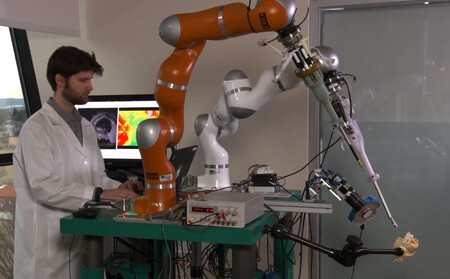This robot has achieved the first surgery without human help: a complex gastrointestinal intervention

A robot has performed the first surgery without humans to guide it. It is a “delicate and complex” intervention in which two ends of the intestine of a pig had to be connected. This step, according to researchers, means a very important advance towards fully automated surgery in humans.
The protagonist is STAR, a robot designed by a team of researchers from Johns Hopkins University that had already shown that it was capable of successfully performing gastrointestinal interventions in pigs. However, to access the intestine he had to make a large external incision and still required some human guidance.
A robot surgeon “significantly better than humans”
In the most recent tests, an improved version of STAR, applied the laparoscopic technique (which only requires small incisions through which the instruments required for the operation are inserted) in four pigs for an intestinal anastomosis and the procedure was successful.
Axel Krieger, professor of mechanical engineering at Johns Hopkins University and one of the authors of the article published in Science Robotics, points out that the robot’s work in gastrointestinal surgeries produced “significantly better results than humans performing the same procedure.

The researchers explain that intestinal anastomosis is a procedure that requires a high level of precision and repetitive motion to connect the two ends of the intestine. Even the slightest tremor in the hand or a poorly placed point can trigger severe complications, they explain, which is why specialist surgeons must have high precision and consistency.

However, the new version of STAR has proven to be prepared for this type of challenge in animals. It incorporates specialized suture tools, an improved imaging system that includes a 3D endoscope, and its new autonomous control system that adapts the surgical plan in real time based on the movements, often unpredictable, of the soft intestinal tissue.
One of the pillars of STAR is a tracking algorithm based on machine learning. “We believe that an advanced 3D machine vision system is essential to making intelligent surgical robots smarter and safer,” says Krieger.
The operating room, an increasingly robotized site
Decades ago it seemed like a science fiction concept to think of a robotic presence in the operating room. However, technological advances have shown us otherwise. Sophisticated systems like Da Vinci allows surgeons to expand their capabilities of vision, precision and control in multiple procedures.
Although also, as we have seen in Xataka, projects such as the one at the University of Oxford are emerging, which has already achieved successfully perform the first traditional retinal operations. Although these have required human assistance, they open the door to new forms of treatment in the field of ophthalmology.
And, on the other hand, there are also projects like that of some researchers from the University of California who, in collaboration with Intel, wanted to teach a robot to suture. The technique? That the robot, powered by an image recognition artificial intelligence system, learned from public videos of surgeons suturing.
Pictures | Universidad Johns Hopkins
Reference-www.xataka.com